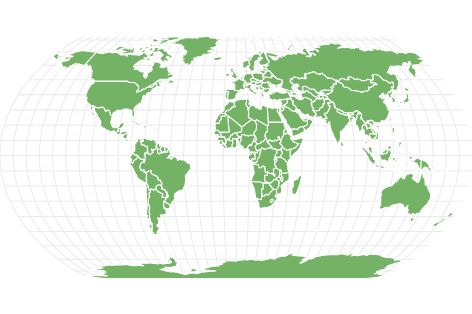Barnacle
Closely related to crabs and lobsters!
Advertisement
Barnacle Scientific Classification
Read our Complete Guide to Classification of Animals.
Barnacle Conservation Status
Barnacle Facts
- Main Prey
- Plankton, Algae
- Fun Fact
- Closely related to crabs and lobsters!
- Distinctive Feature
- Latch on to hard surfaces and shell made up from plates
- Optimum pH Level
- 4.0-6.5
- Habitat
- Shallow marine environments
- Predators
- Fish, Crabs, Humans
- Diet
- Omnivore
- Favorite Food
- Plankton
- Common Name
- Barnacle
- Average Clutch Size
- 1000
View all of the Barnacle images!
If you’ve heard of someone being referred to as a barnacle, it means they’re overly clingy.
What is a barnacle? The barnacle is one of the oldest surviving creatures on earth and lives in oceans around the world. It is a small crustacean that attaches to the hard surfaces of rocks, sea walls, boats, debris, land structures, and other marine animals, such as sea turtles, sea snakes, lobsters, crabs, and whales. This arthropod is a member of the subphylum Crustacea, which includes crabs, lobsters, shrimps, prawns, crayfish, krill, and woodlice.
It forms a symbiotic relationship with other marine animals by creating a plate of armor in return for being transported to plankton-rich waters in which to use filter feeding. Many humans consume the edible gooseneck species.
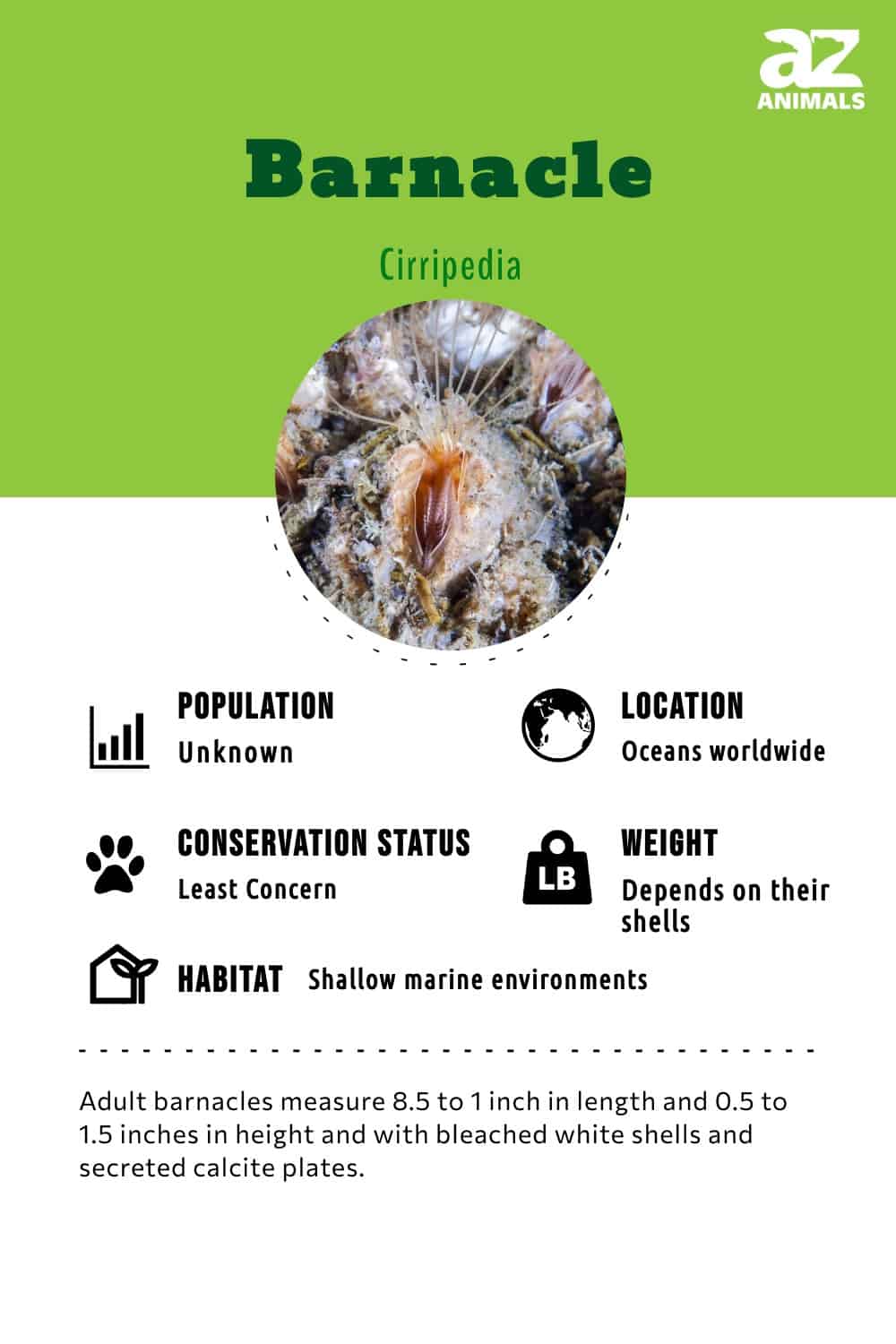
6 Incredible Barnacle Facts!
- It is one of the oldest living animals in the world.
- It was once believed to be related to snails, which are mollusks, because of the hard shell which many species have.
- It eats with tiny legs or feet called “cirri” while suspension feeding
- The rhizocephalan barnacle is a parasite.
- Commensalism refers to the symbiotic relationship a barnacle has with another marine animal where the barnacle has most of the benefit.
- It is hermaphroditic.
There are no type species for the barnacle, so there is no one scientific name. Barnacles are members of the marine invertebrate class Maxillopoda. The subclasses are Thecostraca, Tantulocarida, Branchiura, Pentastomida, Mystacocarida, Copepoda, and Cirripedia. From Theocostraca, the infraclass Cirripedia was divided into superorders Thoracica, Acrothoracica, and Rhizocephala, and then into 11 orders.
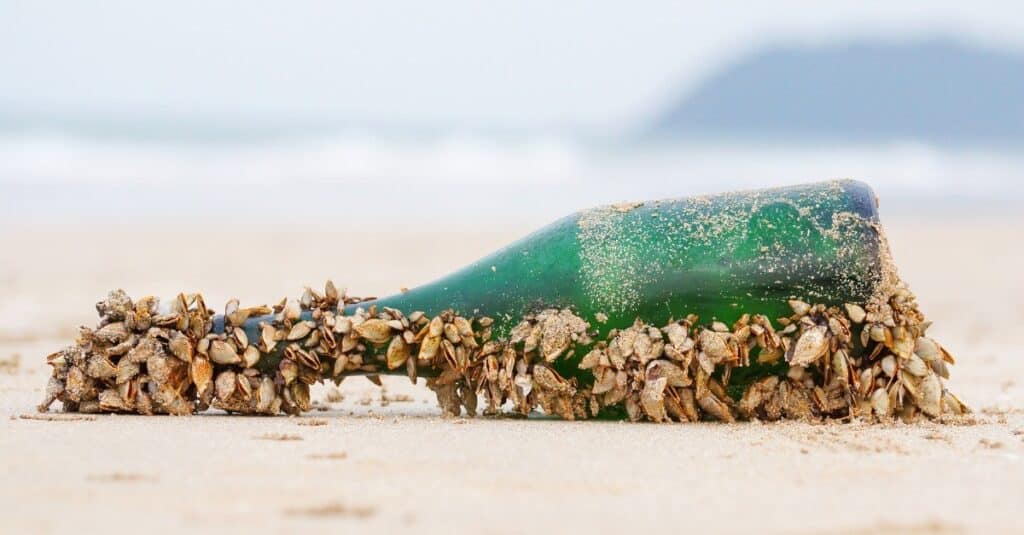
Barnacles are members of the marine invertebrate class Maxillopoda.
©wk1003mike/Shutterstock.com
Scientific Name and Types of Barnacles
There are more than 14,000 species of barnacles, with the most common being the acorn barnacle. However, many species have the common name of acorn barnacle. The scientific name of an acorn barnacle can include the genera Balanus, Chthamalus, Megabalanus, Paraconcavus, or Semibalanus:
- Common Acorn Barnacle (Balanus glandula) – Very common around North America’s Pacific Coast, these barnacles are able to draw oxygen from both air and water. Overall, they have a conical shape and can live up to 10 years.
- Giant Acorn Barnacle (Balanus nubilus) – Rightfully named, this is the world’s largest barnacle. They can be found on the Pacific coast of North America, from Baja California to Alaska and at ranges up to 300ft deep.
- Acorn Barnacle (Chthamalus antennatus) – Also known as the six-plated barnacle – these barnacles are found on the eastern and southern coasts of Australia.
- Titan Acorn Barnacle (Megabalanus coccopoma) – This type of barnacle was first written about by none other than Charles Darwin. These can be found in South and Central America on their Pacific coasts. They are a large, conical barnacle.
- Titan Acorn Barnacle (Megabalanus tintinnabulum)
- Red-striped Acorn Barnacle (Paraconcavus pacificus) – These are a type of balanid barnacles that grow up to just under one and a half inches. They have pink stripes which are striated over their plate growth rings.
- Northern Acorn Barnacle (Semibalanus balanoides) – These are also known as the Common Barnacle and Northern Rock Barnacle. They are a very commonly-occuring version and can be found in rocky areas of the western European coasts and also on western and eastern coasts of North America.
Gooseneck barnacles also called stalked or goose barnacles, are also common. They are the common name for the members of the infraclass Thoracica and the order Pedunculata. The scientific name of a gooseneck barnacle can include the genera Pollicipes and Lepas.
- Goose or leaf barnacle (Pollicipes polymerus)
- Gooseneck Barnacle (Pollicipes pollicipes) – These are stalked versions of the barnacle. They are found on Pacific rocky shores of North America where they directly compete with other animals for limited living space.
- Smooth Gooseneck Barnacle (Lepas anatifera) – Also known as Pelagic Gooseneck Barnacles, these barnacles use their stalks to attach to all types of driftwood, piers, hulls, and flotsam.

©Ennie/Shutterstock.com
History and Evolution
The barnacle is one of the oldest types of animals. They have survived for hundreds of millions of years, and the oldest fossil is over 300 million years old! They evolved into something closer to their modern form about 20 million years ago.
Scientists are able to infer information about water depths from prehistoric times based on barnacle fossils and evidence. They are able to do this by the placement of these findings and estimating the distances of them sloping downward and deeper into oceans.
Appearance
What is a barnacle’s characteristics? A barnacle has specific anatomy depending on its species and whether it is in a larval stage of either the nauplius or cyprid or are mature adults. The nauplius larva hatches from a fertilized egg and has one eye, a head, and a telson, but no thorax or abdomen. It then goes through several moltings to shed its cuticle, during which it looks like shrimp until they become juvenile adults.
Adult barnacles measure 8.5 to 1 inch in length and 0.5 to 1.5 inches in height, depending on the species. Their color is usually white, cream, yellow, or black, and their shells are bleached white. Barnacles secrete 4 to 8 calcite plates with an average of 6 to protect their soft bodies. Adult barnacles have few internal organs and no appendages in their anatomy except for legs or feet, called “cirri,” which they use for feeding and breathing. They have no heart or gills. There’s no information about their weight, and it would mostly be the weight of their shells.
The barnacles that encrust themselves onto boat hulls, buoys, and piers are volcano-shaped, stony, and grey in color. Gooseneck barnacles have a stalk to attach to hard surfaces with, but acorn barnacles do not and are cone-shaped. Acorn barnacles also have an “operculum” or opening at the top which has a “door” of 2 or 4 additional plates, while gooseneck barnacles have chalky-white, heart-shaped shells with black lines. Each type of barnacle has different anatomy.

The barnacles that encrust themselves onto boat hulls, buoys, and piers are volcano-shaped, stony, and grey in color.
©Natursports/Shutterstock.com
Behavior
The behavior of the barnacle during its life cycle for free-swimming and feeding is often called inter-tidal, which refers to its acting long with the ocean tides. When the tide comes, it opens its “door” plates and feeds using its cirri, shutting its operculum to save water. Many barnacles hibernate during winter, relying only on their energy reserves.
Habitat
The barnacle larvae free-swim for a short while after hatching from the egg in order to find a surface to attach to. It tends to settle in sites where there are many other barnacles, meaning they are supportive of life. The surface it settles on must first have a film of algae, seaweed, bacteria, or diatoms to allow it to attach. Once it settles, it becomes sessile, and may not move for the rest of its life.
It lives in marine waters around the globe on rocks, boats, and sea creatures such as whales, fish, and crustaceans. Because barnacles tend to encrust large numbers on boats, create drag, and need pressure washing to remove, they are often called “crusty foulers.” When they are piled on, they are said to be biofouling — meaning they are damaging it — and create drag.
Rhizocephala barnacles live inside thoracican barnacles, mantis shrimps, and other crustaceans. Some non-parasitic barnacles attach to sites by growing their shells into the surface, while other species use a strong glue and peduncle (stalk) to attach themselves head-first.
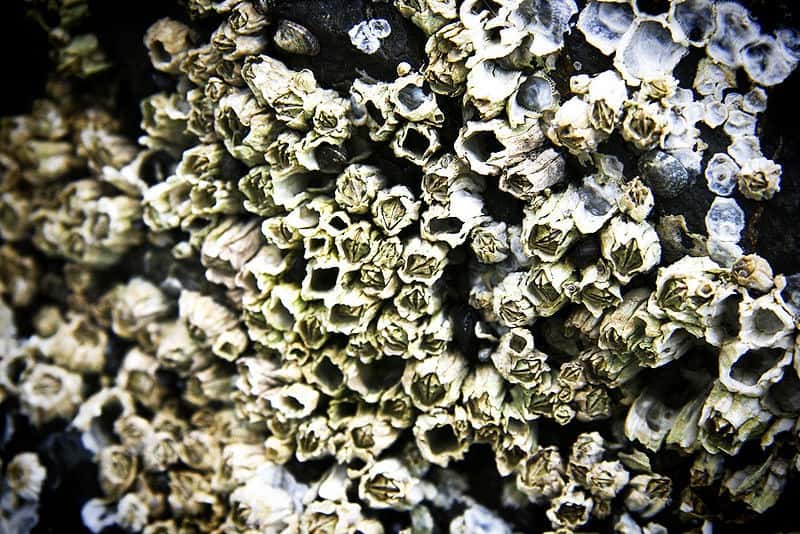
Because barnacles tend to encrust large numbers on boats, create drag, and need pressure washing to remove, they are often called “crusty foulers.”
Diet
The diet of the barnacle is plankton and detritus (dead organic particles), which it consumes through suspension-feeding and filter-feeding. It uses its cirri which it extends and retracts to push the food inside, and opens its operculum to allow water, after which it closes its operculum. A barnacle’s diet is omnivorous because it eats both plant and animal matter.
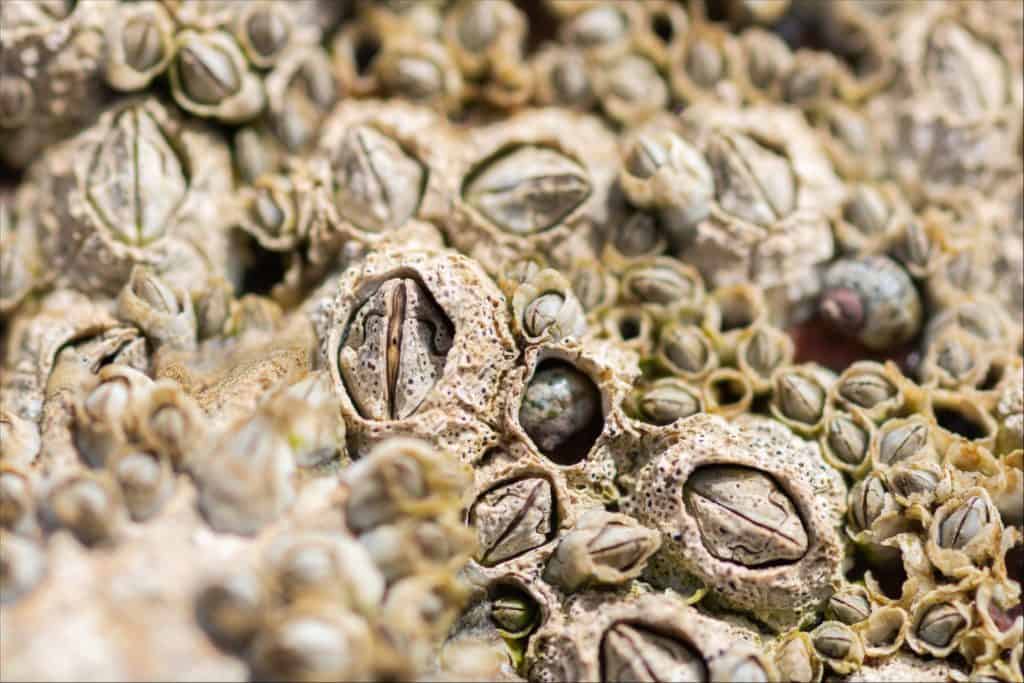
Barnacles are often called “crusty foulers” because of their tendency to encrust in large numbers on boats, creating drag.
©Alexisaj/Shutterstock.com
Predators and Threats
The barnacle has many threats, including other barnacles, which it competes with for space. Other predators include mussels, starfish, limpets, whelks, and other sea snails. The barnacle is especially vulnerable to predators during the larval stages of its life cycle. If barnacles are kept as pets, other animals in the aquarium are likely to prey on them.
Barnacles are also considered a delicacy for some humans, such as in Spain, Portugal, and other European countries. It is the Pudenculata (gooseneck) order barnacles that are edible and have a fleshy stem. The barnacles are scrubbed clean and steamed in broth with herbs and wine, after which the stem is peeled off and eaten with the soup. Acorn barnacles are not edible because they have less flesh on their stems and have high levels of accumulated toxins.
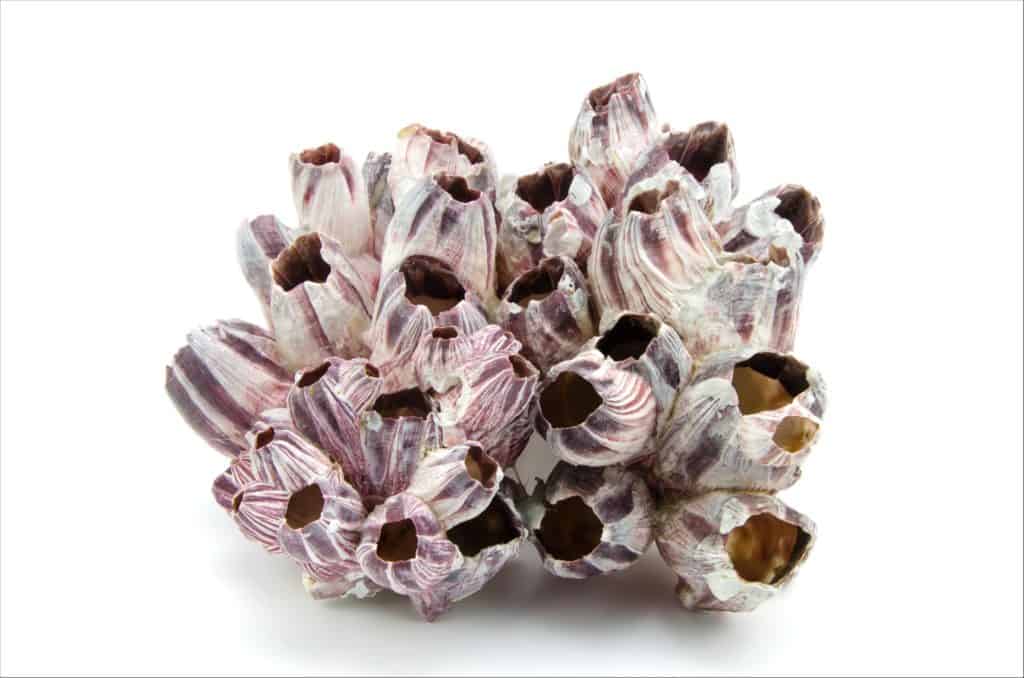
Gooseneck barnacles are edible and have a fleshy stem.
©Seashell World/Shutterstock.com
Reproduction, Babies, and Lifespan
Barnacles are hermaphroditic but cannot reproduce by self-fertilization and need to settle with other barnacles to reproduce as well as to be near food sources. When ready to reproduce, one barnacle becomes receptive to the other’s gametes, which has a very long penis it extends 6 to 8 inches.
The life cycle of a new barnacle starts with the egg, two larval stages, and then juvenile onto full adulthood. The barnacle has a mantle cavity into which it gestates hundreds of eggs at a time, and up to 6 broods a year. The eggs spend winter inside the sac and hatch into baby barnacles, called larvae. The first larval stage is called Nauplius and involves free-swimming for 6 months, after which the larva transforms into the second larval stage, Cyprid, which lasts anywhere from a few days to a few weeks. During this time, the cyprid searches for a suitable surface to attach to. It then secretes a sticky glue from the cement gland on the bottom of its antennae, begins producing a hard outer shell, and transforms into a juvenile adult. Barnacles are sexually mature at two years.
The lifespan of a barnacle depends on its species. Its lifespan can be anywhere from 18 months to 10 years or more, but the average is 5 to 10 years.

The life cycle of a new barnacle starts with the egg, two larval stages, and then the juvenile into full adulthood.
©RLS Photo/Shutterstock.com
Population
Barnacles do not move once they attach to a surface or a host, so they are especially vulnerable to their environment. Certain barnacle species are threatened, endangered, or nationally endangered. One threat is coastal pollution from the dumping of garbage, plastics, industrial runoff, chemical spills, sewage, and animal agriculture. Other threats are mangrove forest clearing and deep-sea trawling for scraping underwater mountain ranges, which result in habitat loss for them.
View all 285 animals that start with BBarnacle FAQs (Frequently Asked Questions)
Are Barnacles herbivores, carnivores, or omnivores?
Barnacles are Omnivores, meaning they eat both plants and other animals.
What Kingdom do Barnacles belong to?
Barnacles belong to the Kingdom Animalia.
What phylum do Barnacles belong to?
Barnacles belong to the phylum Arthropoda.
What class do Barnacles belong to?
Barnacles belong to the class Crustacea.
What family do Barnacles belong to?
Barnacles belong to the family Thecostraca.
What order do Barnacles belong to?
Barnacles belong to the order Maxillopoda.
What type of covering do Barnacles have?
Barnacles are covered in shells.
In what type of habitat do Barnacles live?
Barnacles live in shallow marine environments.
What are some distinguishing features of Barnacles?
Barnacles latch on to hard surfaces and have shells made up from plates.
What do Barnacles eat?
Barnacles eat plankton and algae.
What are some predators of Barnacles?
Predators of Barnacles include fish, crabs, and humans.
What is the average clutch size of a Barnacle?
Barnacles typically lay 1,000 eggs.
What is an interesting fact about Barnacles?
Barnacles are closely related to crabs and lobsters!
What is the lifespan of a Barnacle?
Barnacles can live for 8 to 20 years.
What is the optimal pH for a Barnacle?
The optimal pH for a Barnacle is between 4.0 and 6.5.
What is a barnacle?
A barnacle is a small crustacean that lives in the ocean.
What does a barnacle look like?
It looks like a shrimp, but is either shelled or naked.
Are barnacles harmful?
Yes, they are harmful to boats and building. Their damaging behavior is called “biofouling.”
What does a barnacle do?
From its name alone, a barnacle implies being sticky and hard to remove. It hatches from an egg, floating around and undergoing two larval stages before it finds a suitable surface to attach to. It then starts changing into a juvenile and then a juvenile adult, after which it might not move for the rest of its life. A barnacle cannot move by itself as as a larva engages in free-floating from the tide’s movements.
Can you eat barnacles?
Yes, gooseneck barnacles are edible, which have a fleshy stem.
How to say Barnacle in ...
Thank you for reading! Have some feedback for us? Contact the AZ Animals editorial team.
Sources
- Wikipedia, Available here: https://en.wikipedia.org/wiki/Barnacle
- Florida Museum, Available here: https://www.floridamuseum.ufl.edu/science/five-facts-barnacles/
- Reference, Available here: https://www.reference.com/science/symbiotic-relationship-between-barnacle-whale-5a104284ed3ef1a4
- National Ocean Service, Available here: https://oceanservice.noaa.gov/facts/barnacles.html
- Jupiter Research Foundation, Available here: http://jupiterfoundation.org/current/2018/3/26/oh-barnacles-those-crusty-foulers-ms7c8
- World Animal Foundation, Available here: https://www.worldanimalfoundation.com/advocate/wild-animals/params/post/1291247/barnacles
- Outside Type, Available here: https://outsidetype.com/5-types-of-barnacles/
- NOAA, Available here: https://oceanservice.noaa.gov/facts/barnacles.html

